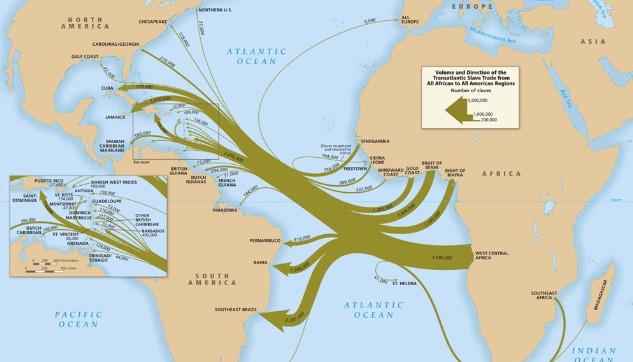TRANS-ATLANTIC SLAVE TRADE
To get started this digital history project is on the basis of the Transatlantic Slave Trade. It is more focused on the three-dimensional modeling of the ship(s) used and the maps shown. Here is where you will be able to find the website. This website is specifically used to inform the user or audience more about the Transatlantic slave trade but also show visuals of it as well. It was created before 1999 but published in 1999 and has been making changes over the course of the next two decades following its publishing.
To get started with the project review we ask who did it. The site itself has multiple contributors and changes every time it is updated so to say there is one person involved would be a discrediting issue. So in compliance with this the contributors are mentioned in subsections, Steering committee, operational committee and the host of the website. The host of the website is Rice University. The Steering Committee contributors are Alex Borucki, Daniel B. Domingues da Silva, Paul Gardullo, Martha Howard, Tara Inniss, Allen Tullos, Geoff Ward, and Abby Wolf. For the Operational Committee the contributors are David Eltis, Alex Borucki, Daniel B. Domingues da Silva, Martha Howard, Jane Hooper, Nafees M. Khan, Gregory E. O’Malley, Kate McMahon, Maria R. Montalvo, Philip Misevich, Nicholas Radburn, Kelly Schmidt, Jelmer Vos, Jennie K. Williams, and Rodney Worrell. It makes it easier to know what type of digital medium is used. In this digital project the contributors used a website, web pages, images, and audio to explain and inform the audience. In terms of this there are more examples or types of the digitals mediums to go on and on about but to go too in depth of finding the different types would take a long time, so these are just the basics. Here is an example of one of the images used.

When analyzing this I continued to ask myself why, why was this created, why is this digital project interesting enough to be edited and changed so often. My final answer to that is that there can be so many reasons as to why one and/or more people would create this. My biggest reasoning would be to inform the audience and give visuals to the people looking to seek research on the topic or just for those that are trying to learn more about it. In my opinion this project does not really have a thesis because it is more or less information about the trans-Atlantic Slave Trade than an argument about it. The visuals used are to inform the reader and guide them to a better understanding of the voyages and the ship(s) involved in these such voyages. In the context of history I think this is more of an interactive lesson type deal. This is due to the fact that the audience is able to interact with this site and see more than just paragraphs of inform but it also has pictures, digital images and videos. The site has some hyper links that take you to other places on the site. This can lead you to a multitude of things, one being the section of the 3-D slave ship(s). This is where the viewer can see multiple pictures in a video format and how the slave on the ship laid. This video had a voice and kind of would explain each picture being shown as well as give a little lesson. This project connects many of the ideas we learned in the class. It covers hyperlinking and hypertext as well as one of my favorite digital images along with the use of voice overs to video recordings. It also covers the use of digital/digitizing of data, being that some of the information could have been received from books and other sources that may not have already been digitalized.
With this project I did not find many if not any issues or critics that I have. I think the creators of the digital history project did a great job with informing the viewers and audience about the explorations of the trans-Atlantic Slave Trade. One thing that I would mention to the creators is when they add or make changes keep a section or two about the information that was previously stated therefore we can go back to that as well as have the new stuff. In the end this was and is a great project on informing us and I think this has great potential to be a great form of studying learning and a source for research for future viewers.
Works Cited
Eltis, David & Richardson, David. Volume and Direction of the trans-Atlantic Slave Trade. Jan. 1, 2022. Explore the Origins and Force Relocations of Enslaved Africans Across the Atlantic World. https://www.slavevoyages.org/
University, Rice. “Explore the Origins and Forced Relocations of Enslaved Africans across the Atlantic World.” Slave Voyages, 1999, https://www.slavevoyages.org/.